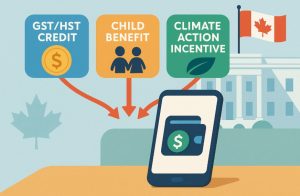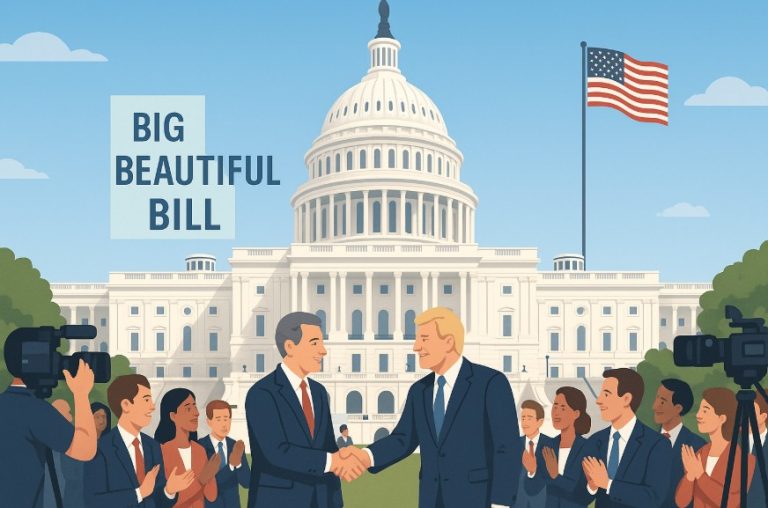Have you ever noticed a deposit from “Canada FPT” in your bank account and wondered what it was? That’s likely your GST/HST credit, a tax-free benefit designed to help with rising living costs. With prices climbing across Canada, this quarterly payment offers essential relief for lower and modest-income individuals and families.
The Canada Revenue Agency (CRA) administers this benefit without requiring a separate application. Whether you’re a student, single parent, senior, or newcomer, you may be eligible for this valuable credit.
And with new increased payments hitting accounts from July 4, 2025, it’s important to understand what this payment is, how much you might receive, and how to ensure you don’t miss it.
In this guide, you’ll find everything you need to know about eligibility, payment dates, application tips, and more. Let’s break it all down in a simple, informative way.
What Is the GST HST Credit in Canada?

The GST/HST credit is a quarterly tax-free payment provided by the CRA to help Canadians offset the Goods and Services Tax (GST) or Harmonized Sales Tax (HST) they pay on everyday purchases.
This benefit is specifically aimed at lower and modest-income residents across the country. It plays a crucial role in reducing the burden of sales taxes on individuals and families who might otherwise struggle with basic expenses.
The credit:
- Is non-taxable, meaning you don’t need to include it on your tax return
- Is automatically calculated based on your income tax filing
- Offers additional support for children under 19
Introduced to ease the financial pressure created by taxation, the credit has grown in importance in recent years. Rising inflation and increased living costs have made this quarterly payment a vital lifeline for many.
Payments are made every three months and are adjusted yearly based on your previous tax return. Whether you’re working part-time, receiving social assistance, or just getting by, this benefit ensures a portion of your sales taxes is returned to you. In short, it’s one of Canada’s simplest yet most powerful tax benefits for eligible residents.
Who Is Eligible for the GST HST Credit?
To qualify for the GST/HST credit, you must meet certain residency, age, and income criteria set out by the CRA. This ensures that the benefit reaches those who need it most.
To be eligible:
- You must be a resident of Canada for tax purposes
- You must be 19 years or older, or
- If under 19, you must have a spouse, common-law partner, or child you live with
- You must have filed a tax return, even if you had no income
The CRA uses your tax return to determine if you’re eligible and how much you qualify for. If you’re a newcomer, temporary resident, or protected person, you may also qualify by submitting the required forms to the CRA.
Income Criteria is another vital aspect:
- Payments are based on your Adjusted Family Net Income (AFNI)
- Credits start to phase out above certain income thresholds
- Your marital status and number of children also impact your eligibility
Always make sure your personal and financial information with CRA is up to date to avoid delays or miscalculations.
How Much Can You Receive from the GST HST Credit?

The amount you receive from the GST/HST credit depends on your adjusted family net income (AFNI), your marital status, and the number of children under 19 in your care. These payments are reviewed annually based on the tax return you filed the previous year. For 2025–2026, the CRA has updated the benefit amounts to reflect cost-of-living changes across Canada.
If your income is below a certain threshold, you may be eligible for the full credit, and if it falls above the limit, you may receive a reduced or no payment. The credit is designed to offer the most support to lower-income Canadians, including singles, couples, and families.
Payment Amounts for Individuals, Families, and Children
Here are the maximum annual federal GST/HST credit amounts for July 2025 to June 2026:
- Single individual: $533
- Couples without children: $698
- Per child under 19: $184
- Maximum per child (provincial top-ups may apply): Varies by province
Residents in Newfoundland and Labrador, New Brunswick, Nova Scotia, and PEI may receive additional provincial top-ups alongside the federal amount.
Breakdown Table of Payment Amounts by Income Level
| Adjusted Family Net Income (CAD) | No Children | 1 Child | 2 Children | 3 Children | 4 Children |
|---|---|---|---|---|---|
| Under 11,337 | $349.00 | $882.00 | $1,066.00 | $1,250.00 | $1,434.00 |
| 12,000 | $362.00 | $882.00 | $1,066.00 | $1,250.00 | $1,434.00 |
| 15,000 | $422.00 | $882.00 | $1,066.00 | $1,250.00 | $1,434.00 |
| 20,000 | $522.00 | $882.00 | $1,066.00 | $1,250.00 | $1,434.00 |
| 25,000 | $533.00 | $882.00 | $1,066.00 | $1,250.00 | $1,434.00 |
| 30,000 | $533.00 | $882.00 | $1,066.00 | $1,250.00 | $1,434.00 |
| 35,000 | $533.00 | $882.00 | $1,066.00 | $1,250.00 | $1,434.00 |
| 40,000 | $533.00 | $882.00 | $1,066.00 | $1,250.00 | $1,434.00 |
| 45,000 | $533.00 | $882.00 | $1,066.00 | $1,250.00 | $1,434.00 |
| 50,000 | $309.05 | $658.05 | $842.05 | $1,026.05 | $1,210.05 |
| 55,000 | $59.05 | $408.05 | $592.05 | $776.05 | $960.05 |
| 60,000 | $0.00 | $158.05 | $342.05 | $526.05 | $710.05 |
| 65,000 | $0.00 | $0.00 | $92.05 | $276.05 | $460.05 |
| 70,000 | $0.00 | $0.00 | $0.00 | $26.05 | $201.05 |
| 75,000 | $0.00 | $0.00 | $0.00 | $0.00 | $0.00 |
GST Payment for Married or Common Law Couples (2025–2026)
| Adjusted Family Net Income (CAD) | No Children | 1 Child | 2 Children | 3 Children | 4 Children |
|---|---|---|---|---|---|
| Under 45,521 | $698.00 | $882.00 | $1,066.00 | $1,250.00 | $1,434.00 |
| 46,000 | $674.00 | $858.00 | $1,042.05 | $1,226.05 | $1,410.05 |
| 50,000 | $474.00 | $658.00 | $842.05 | $1,026.05 | $1,210.05 |
| 55,000 | $224.00 | $408.00 | $592.05 | $776.05 | $960.05 |
| 60,000 | $0.00 | $158.05 | $342.05 | $526.05 | $710.05 |
| 65,000 | $0.00 | $0.00 | $92.05 | $276.05 | $460.05 |
| 70,000 | $0.00 | $0.00 | $0.00 | $26.05 | $210.05 |
| 75,000 | $0.00 | $0.00 | $0.00 | $0.00 | $0.00 |
Examples for Clarity
To better understand the credit calculation:
- A single parent earning $30,000 with 2 children would receive approximately $1,066 annually
- A married couple with 1 child earning $50,000 might qualify for about $658
- A single individual with no children making $20,000 could get $522
These estimates assume timely tax filing and up-to-date information with CRA. If your income is low enough, you may receive the full payment quarterly. If your amount is less than $50 per quarter, CRA may issue it as a one-time lump sum in July. Always check your CRA My Account to view your personal benefit amounts and ensure everything is accurate.
When Are the GST HST Credit Payments Made?
The CRA issues GST/HST payments four times per year.
For the 2025–2026 payment year, here are the official payment dates:
- July 4, 2025
- October 3, 2025
- January 5, 2026
- April 3, 2026
Payments usually arrive via direct deposit or cheque. If you don’t receive your payment within 10 business days, contact CRA.
Make sure to:
- File your tax return on time
- Update your banking and address details
- Monitor CRA My Account for updates
These payments are automatically issued based on your most recent tax filing, with no application required.
How Do You Apply for the GST HST Credit?

Getting the GST/HST credit is a straightforward process, especially for most Canadians. Here’s what you need to know to make sure you don’t miss out.
Automatic Application via Tax Return
When you file your annual tax return, the CRA automatically determines your eligibility. There’s no separate application form unless you’re a newcomer to Canada.
- File taxes every year, even with zero income
- Ensure accurate marital status and number of dependents
My CRA Account Details
Logging into your CRA My Account allows you to:
- Check payment dates and amounts
- View your eligibility status
- Update direct deposit and mailing address
Having access to this portal makes tracking and managing your GST/HST credits much easier.
Common Mistakes to Avoid
- Not filing taxes, assuming you’re ineligible
- Not updating family status or income changes
- Relying on paper cheques instead of direct deposit
Avoiding these errors ensures you receive accurate and timely payments. Always double-check your return before filing.
What If You Didn’t Receive Your GST HST Credit?
If your payment is missing or delayed, there could be several reasons. First, confirm the scheduled date and allow at least 10 business days for delivery.
Here are common causes of non-payment:
- You didn’t file your recent tax return
- Your income details were incorrect or incomplete
- You recently changed your address or banking info
- Your credit was below the minimum threshold and issued as a lump sum
Check your CRA My Account for the most up-to-date status. If it shows that payment was issued but not received, contact CRA at 1-800-387-1193 for support.
Staying proactive with your information can help prevent future issues.
How Does the GST HST Credit Affect Other Benefits?

The GST/HST credit works in complement with other Canadian benefits.
It doesn’t reduce or conflict with payments such as:
- Canada Child Benefit (CCB)
- Climate Action Incentive Payment (CAIP)
- Provincial top-ups where applicable
In some cases, these benefits may appear combined as a Canada FPT deposit in your bank account. The GST/HST credit is non-taxable, so it won’t affect your total income for tax filing or social assistance purposes.
It also doesn’t impact your eligibility for other income-tested programs. Just make sure your income and dependent data are accurate with CRA to receive all applicable credits.
Is the GST HST Credit Increasing in 2025?
Yes, the federal government has announced increased GST/HST credit amounts for the 2025–2026 cycle. This reflects efforts to address rising inflation and the high cost of living.
The increases include:
- An annual maximum of $533 for singles
- $698 for couples without children
- $184 per child under 19
Some Atlantic provinces are also offering provincial top-ups this year. Residents in Newfoundland and Labrador, Nova Scotia, New Brunswick, and PEI may receive extra quarterly amounts, which will be added to the federal payment. Check your CRA My Account and your province’s website to see if you qualify for the additional boost.
How to Make Sure You Never Miss a GST HST Payment?

To ensure smooth and timely delivery of your GST/HST credit, follow these steps:
- Set up direct deposit through CRA or your financial institution
- Keep your address and marital status updated with the CRA
- File your taxes every year, even with no income
These actions prevent missed or delayed payments. You can also enable email notifications through CRA My Account so you’re alerted about deposit status. Setting reminders for the payment dates and checking your account regularly will help you stay on top of your benefits.
Conclusion
The GST/HST credit payment in Canada is more than just a financial bonus, it’s a crucial support system for millions of people navigating rising costs. Whether you’re new to the country, living on a modest income, or supporting a family, this quarterly tax-free payment can make a real difference.
By understanding how it works, when it arrives, and how to ensure you get it, you’re one step closer to keeping your finances in check. If you haven’t already, take a moment to log into CRA My Account and review your eligibility. The money is there, it’s yours to claim.
FAQs
Can students receive the GST HST credit in Canada?
Yes, as long as you’re 19 or older and meet the income requirements, you can qualify even if you’re a student.
Do newcomers to Canada qualify for GST HST payments?
Yes, newcomers can qualify after meeting residency requirements and submitting the appropriate CRA forms.
What does the GST HST credit deposit look like on my bank statement?
It typically appears as Canada FPT or GST/HST credit on your bank statement.
How do I update my banking info with CRA for GST HST payments?
You can update your direct deposit details through CRA My Account or by calling CRA directly.
Is the GST HST credit taxable income?
No, the GST/HST credit is completely tax-free and doesn’t count as taxable income.
What should I do if my payment is lower than expected?
Check your Notice of Assessment or CRA My Account to review your income and dependents, any change could affect your amount.
Can I receive GST HST credit if I didn’t file taxes?
No, filing your annual tax return is required to be considered for the GST/HST credit.




